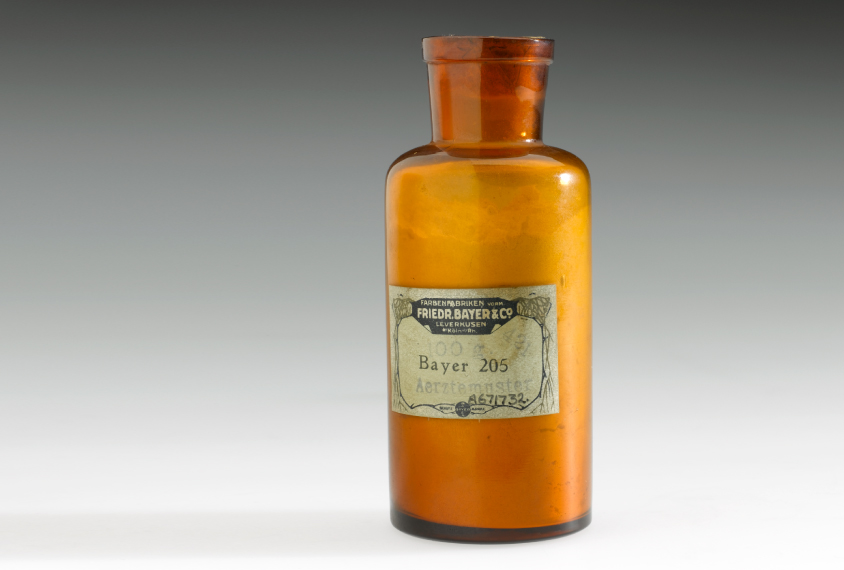
Photograph courtesy Science Museum, London
THIS ARTICLE IS MORE THAN FIVE YEARS OLD
This article is more than five years old. Autism research — and science in general — is constantly evolving, so older articles may contain information or theories that have been reevaluated since their original publication date.
A drug normally used to treat African sleeping sickness had only mild side effects in a widely reported trial of 10 boys with autism. But many researchers question the trial’s rationale and caution that serious side effects may emerge in larger studies.
Half the boys in the trial received a single low dose of the drug, called suramin, intravenously. All five developed a mild rash but experienced no other health problems, researchers reported in May in the Annals of Clinical and Translational Neurology1.
But suramin is not a benign medication. In higher doses, it is known to cause anemia and problems with the adrenal gland, which makes hormones, including the stress hormone cortisol.
“If I had someone with [autism] in my family, I would certainly not immediately jump to using this as a treatment,” says David Sulzer, professor of psychiatry, neurology and pharmacology at Columbia University. “It easily could be that a sizeable fraction of people who might take this in the future develop additional side effects, which could be bad side effects.”
The boys who received the drug showed modest improvements in autism features relative to the five boys in the control group. However, the study was not designed to assess the drug’s effectiveness. The rash may have tipped off the parents as to whether their child was in the treatment or control group — and may have contributed to a placebo effect.
Lead researcher Robert Naviaux says the trial wasn’t intended to test suramin for treating autism. Instead, he says, it was meant to test whether suramin’s known mechanism of action — blocking receptors involved in the stress response — is important in the condition.
“A lot of people mistakenly think that our study was about suramin; it was not,” says Naviaux, professor of genetics at University of California, San Diego. “Our study was designed as a first test of a new unifying hypothesis for the cause and treatment of autism.”
Alarm bells:
Suramin blocks proteins called purinergic receptors on the surface of cells. These receptors ordinarily transmit a ‘danger’ signal when a cell is stressed2. Naviaux says this stress response may go into overdrive in autism, so blocking purinergic receptors could restore the cell’s equilibrium.
In a 2014 study, Naviaux and his colleagues injected suramin into 6-month-old mice that were exposed to a mock infection in the womb. A single dose of the drug improved the animals’ social behaviors for five weeks, the researchers reported3. The following year, the team reported that suramin improves social behavior in a mouse model of fragile X syndrome4.
In the new trial, Naviaux’s team used the Autism Diagnostic Observation Schedule (ADOS) to rate the autism features of 10 boys both before and 45 days after they received the drug or placebo. Parents also rated autism severity using other measures at two time points: one week and 45 days after the treatment.
The boys who received suramin improved significantly more on all of these measures than did the five boys whose infusions contained just saline. In particular, boys in the suramin group scored an average of 1.6 points lower on the ADOS compared with no change among the boys in the placebo group.
Some researchers say the results are promising.
“This change is clinically significant,” says Richard Frye, director of autism research at Arkansas Children’s Hospital Research Institute in Little Rock. “For children who don’t have any other treatment and who have severe symptoms, any improvement in symptoms can really have a large impact on their life.”
Moving forward:
The trial was too small to assess the drug’s efficacy, however, and other researchers say they don’t understand why the drug might work for autism.
Autism is associated with some metabolic problems, such as defects in a mitochondrial protein. Studies of postmortem brain tissue suggest some people with autism have abnormalities in the cell’s energy producers, or mitochondria, and some children with autism carry mutations in their mitochondrial DNA.
But there is no evidence that people with autism have altered stress signaling, says Yong-Hui Jiang, associate professor at pediatrics and neurobiology at Duke University in Durham, North Carolina, who was not involved with the study.
And even if purinergic signaling is at the root of autism, he and others say, it’s unclear that suramin would fix the problem.
“I don’t see how this would lead to something that would really be a reversal permanently of an autism phenotype — unless there’s some very specific mechanism that is involved in autism that this is reversing,” says Mady Hornig, associate professor of epidemiology at Columbia University.
To vet suramin as an autism treatment, researchers say that studies would first need to determine whether the purinergic pathway underlies any forms of the condition. This approach would require finding a biological marker for abnormalities in this pathway and then testing suramin in people who have the abnormality.
There are no studies that prove an altered purinergic pathway causes autism. But Naviaux says data from people with autism or other brain conditions suggest an association between the purinergic pathway and autism5,6.
Naviaux has filed a patent application for an “antipurinergic therapy.” He is also planning a follow-up trial to test the effects of three doses of suramin over three months in as many as 60 children.
By joining the discussion, you agree to our privacy policy.